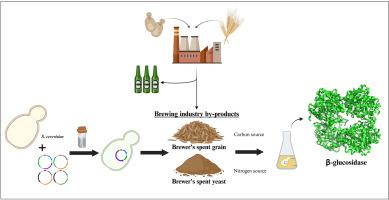利用酿酒工业副产品利用重组酿酒酵母可持续生产β-葡萄糖苷酶
IF 3.8
Q2 BIOTECHNOLOGY & APPLIED MICROBIOLOGY
引用次数: 0
摘要
工业微生物废物生物质的可持续再循环为增值产品提供了一种生态友好和成本效益高的生物商品生产方法。在本研究中,我们对四种表达质粒yEN1-Pccbgl1、yEN1-Pccbgl1、yEN2-Pccbgl1和yEN2-Pccbgl1在酿酒酵母中的β-葡萄糖苷酶活性进行了评价。含有高拷贝数小质粒的重组酿酒葡萄球菌Y294[EN1d-Pccbgl1]菌株在190 U/g DCW时酶活性最高。相比之下,含有整合质粒的菌株酿酒酵母Y294[IN2-Pccbgl1]的酶活性最低,为9.5 U/g DCW。随后,对表现最佳的酿酒酵母Y294[EN1d-Pccbgl1]菌株进行了评估,以啤酒厂废液为原料生产酶。重组菌株在确定的培养基中培养时,β-葡萄糖苷酶的最大活性为~ 1.0 U/mL,与使用10 g/L的Komagataella pastoris或商业化酿酒酵母生物量作为氮源时的活性相当。值得注意的是,当使用啤酒酿造者的废酵母作为氮源时,活性增加到~ 2.0 U/mL。以啤酒糟和啤酒酵母为碳源和氮源时,β-葡萄糖苷酶活性为1.46 U/mL。这与将啤酒酿造者的废谷物与商业纤维素酶结合使用所获得的水平相当。这些发现强调了一种有前途的生物技术方法:将低成本、富含碳水化合物的工业废物流与微生物生物质废物结合起来,用于经济地生产重组酶。这一战略不仅降低了生产成本,而且有助于废物增值和循环生物经济倡议。本文章由计算机程序翻译,如有差异,请以英文原文为准。

Harnessing brewing industry byproducts for sustainable β-glucosidase production by recombinant Saccharomyces cerevisiae
The sustainable recirculation of industrial microbial waste biomass into value-added products offers an eco-friendly and cost-efficient approach to biocommodity production. In this study, we evaluated four expression plasmids: yEN1-Pccbgl1, yEN1d-Pccbgl1, yIN2-Pccbgl1 and yEN2-Pccbgl1 for β-glucosidase activity in Saccharomyces cerevisiae. The recombinant S. cerevisiae Y294[EN1d-Pccbgl1] strain containing the small high copy number plasmid displayed the highest level of enzyme activity at 190 U/g DCW. In contrast, the strain harbouring the integrative plasmid, S. cerevisiae Y294[IN2-Pccbgl1], displayed the lowest enzyme activity at 9.5 U/g DCW. The best performing S. cerevisiae Y294[EN1d-Pccbgl1] strain was subsequently assessed for enzyme production using brewery waste streams as feedstock. Cultivating the recombinant strain in defined media resulted in a maximum β-glucosidase activity of ∼1.0 U/mL comparable to the activity obtained when using 10 g/L Komagataella pastoris or commercial S. cerevisiae biomass as nitrogen sources. Notably, activity increased to ∼2.0 U/mL when brewers' spent yeast was used as the nitrogen source. Furthermore, when brewers' spent grains and brewers' spent yeast were used as carbon and nitrogen sources respectively, 1.46 U/mL of β-glucosidase activity was obtained. This is comparable to levels obtained using brewers’ spent grains in combination with commercial cellulases. These findings highlight a promising biotechnological approach: repurposing low-cost, carbohydrate-rich industrial waste streams in conjunction with microbial biomass waste for the economical production of recombinant enzymes. This strategy not only reduces production costs but also contributes to waste valorisation and circular bioeconomy initiatives.
求助全文
通过发布文献求助,成功后即可免费获取论文全文。
去求助
来源期刊

Biocatalysis and agricultural biotechnology
Agricultural and Biological Sciences-Agronomy and Crop Science
CiteScore
7.70
自引率
2.50%
发文量
308
审稿时长
48 days
期刊介绍:
Biocatalysis and Agricultural Biotechnology is the official journal of the International Society of Biocatalysis and Agricultural Biotechnology (ISBAB). The journal publishes high quality articles especially in the science and technology of biocatalysis, bioprocesses, agricultural biotechnology, biomedical biotechnology, and, if appropriate, from other related areas of biotechnology. The journal will publish peer-reviewed basic and applied research papers, authoritative reviews, and feature articles. The scope of the journal encompasses the research, industrial, and commercial aspects of biotechnology, including the areas of: biocatalysis; bioprocesses; food and agriculture; genetic engineering; molecular biology; healthcare and pharmaceuticals; biofuels; genomics; nanotechnology; environment and biodiversity; and bioremediation.
 求助内容:
求助内容: 应助结果提醒方式:
应助结果提醒方式:


